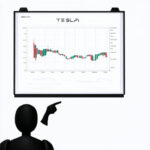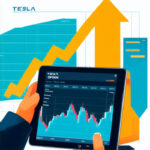The Real Cost to Buy Tesla Stock: Fees, Taxes, and More

Introduction to the Cost to Buy Tesla Stock
Buying Tesla stock might seem as simple as clicking a button, but several costs can impact your investment’s profitability. Understanding these costs is crucial for anyone looking to invest in Tesla shares. From brokerage fees to taxes, and even currency conversion impacts, each factor can add up, affecting your bottom line. This blog post aims to unravel the actual cost to buy Tesla stock, providing you with a comprehensive overview of all the potential expenses involved. By understanding these intricacies, you can make more informed decisions and optimize your investment strategy.
Understanding the Basics of Tesla Stock
Tesla Inc., a pioneer in the electric vehicle sector, has become one of the most sought-after stocks in recent years. Its market performance attracts seasoned investors and novices alike. Before diving into the costs, it’s important to understand the nature of Tesla stock. Known for its volatility, Tesla’s stock price can fluctuate significantly, making timing crucial. Additionally, Tesla does not pay dividends, meaning the return on investment largely depends on stock appreciation. Investors should familiarize themselves with these aspects to better assess the risks and rewards of investing in Tesla shares.
Importance of Knowing the Real Costs
Understanding the real costs associated with buying Tesla stock is vital for maximizing your investment returns. Many investors focus solely on the purchase price, overlooking additional expenses that can erode profits. By being aware of these costs upfront, you can better plan your investment strategy and avoid unexpected surprises. This knowledge can also help in comparing different brokerage options, understanding tax implications, and strategizing on currency conversions. Ultimately, knowing the real costs empowers investors to make informed decisions and optimize their investment outcomes.
Overview of the Blog Post
In this blog post, we will delve into the various costs associated with buying Tesla stock. We’ll explore brokerage fees and commissions, tax implications, currency conversion factors, and other hidden charges that could affect your investment. Additionally, we’ll discuss long-term holding costs and provide strategies to minimize these expenses. By the end of this post, you’ll have a comprehensive understanding of the real cost to buy Tesla stock, enabling you to make more informed investment decisions. Let’s begin by examining the first aspect: brokerage fees and commissions.
Brokerage Fees and Commissions
Choosing the Right Brokerage
Selecting the right brokerage is a critical first step in minimizing the costs of buying Tesla stock. Different brokerages offer varying fee structures, and choosing one that aligns with your investment strategy can save you money. Look for brokerages that provide competitive fees, a user-friendly platform, and reliable customer service. Additionally, consider whether the brokerage offers any educational resources or tools that can aid your investment journey. By taking the time to research and compare options, you can find a brokerage that meets your needs and helps you keep costs low.
Fee Structures: Commission vs. Zero-Commission
Brokerage fees can significantly impact the cost to buy Tesla stock. Traditionally, brokerages charged commissions on trades, but the rise of zero-commission platforms has changed the landscape. While zero-commission platforms may seem appealing, it’s important to be aware of potential trade-offs, such as less favorable order execution or hidden costs. Commission-based brokerages, on the other hand, may offer more personalized services. Evaluate the pros and cons of each fee structure to determine which aligns best with your investment goals and trading frequency.
Hidden Costs in Brokerage Fees
Beyond the obvious commission or zero-commission fees, brokerages may have hidden costs that can affect your investment. These may include fees for account maintenance, inactivity, or even platform usage. Some brokerages also charge for additional services like real-time data feeds or advanced trading tools. It’s crucial to read the fine print and understand all potential charges before committing to a brokerage. By being aware of these hidden costs, you can avoid unexpected expenses and better manage your overall investment costs.
Taxes on Tesla Stock Purchases
Capital Gains Tax Implications
When investing in Tesla stock, it’s essential to consider the tax implications, particularly capital gains tax. When you sell your shares for a profit, the government may require you to pay taxes on the gains. The rate depends on how long you’ve held the stock, with long-term holdings typically taxed at a lower rate. Understanding these tax implications can help you strategize your stock purchases and sales to maximize after-tax returns. Consult with a tax professional to ensure you’re fully aware of your responsibilities and can plan accordingly.
Tax-Advantaged Accounts: Pros and Cons
Investing in Tesla stock through tax-advantaged accounts like IRAs or 401(k)s can provide significant tax benefits. These accounts can allow for tax-deferred growth or even tax-free withdrawals, depending on the account type. However, they also come with limitations, such as contribution caps and early withdrawal penalties. Weighing the pros and cons of using tax-advantaged accounts to purchase Tesla stock is important for aligning your investment strategy with your financial goals. Consult with a financial advisor to determine the best approach for your situation.
Reporting Requirements for Stock Investments
Investing in Tesla stock comes with certain reporting requirements that investors need to be aware of. These may include reporting capital gains and losses on your tax return, as well as disclosing any dividend income. Failing to report these accurately can result in penalties and fines. Keeping detailed records of your stock transactions and consulting with a tax professional can help ensure compliance with reporting requirements. By staying informed and organized, you can avoid potential pitfalls and focus on growing your investment portfolio.
Exchange Rates and Currency Conversion
Impact of Currency Fluctuations on Stock Purchases
For international investors, currency fluctuations can significantly impact the cost of buying Tesla stock. Changes in exchange rates can affect the amount you ultimately pay for shares, as well as the value of your investment when converting back to your home currency. Staying informed about currency trends and using strategies like forward contracts can help mitigate these risks. Understanding how currency fluctuations affect your investments is crucial for making informed decisions and managing potential losses in a volatile market environment.
Strategies to Minimize Currency Conversion Costs
Minimizing currency conversion costs is essential for international investors buying Tesla stock. One strategy is to open a multi-currency account, allowing you to hold and trade in different currencies without frequent conversions. Another approach is to use a brokerage that offers competitive exchange rates and low conversion fees. Additionally, consider timing your purchases when exchange rates are favorable. By implementing these strategies, you can reduce currency conversion costs and enhance the overall profitability of your Tesla stock investment.
Tools and Resources for Investors
Several tools and resources are available to help investors manage the costs associated with buying Tesla stock. Currency conversion calculators, financial news platforms, and stock analysis tools can provide valuable insights and assist in decision-making. Additionally, brokerage platforms often offer educational resources and market research to help investors stay informed. Utilizing these tools can enhance your investment strategy and enable you to make more informed decisions regarding your Tesla stock purchases. By leveraging available resources, you can better navigate the complexities of the investment landscape.
Additional Costs and Hidden Fees
Account Maintenance and Inactivity Fees
Beyond trading fees, some brokerages charge account maintenance or inactivity fees, which can add to the cost of buying Tesla stock. These fees are typically levied if your account balance falls below a certain threshold or if there are no trading activities over a specified period. It’s important to review your brokerage’s fee schedule to understand these charges and find ways to avoid them. By staying active in your account and maintaining the required balance, you can minimize these additional costs and keep more money invested in your Tesla stock.
Transfer Fees and Settlement Charges
Investors should be aware of transfer fees and settlement charges when buying Tesla stock. Transfer fees may apply when moving assets between brokerages, and settlement charges can occur during the clearing process of trades. These costs can add up, particularly for frequent traders or those moving large amounts of stock. To minimize these expenses, choose a brokerage with competitive transfer and settlement fees, or consider consolidating your investments to reduce the need for frequent transfers. By understanding these charges, you can better manage your investment costs and enhance your portfolio’s profitability.
Margin Account Costs
Investors using a margin account to buy Tesla stock should be aware of the associated costs. Margin accounts allow you to borrow funds from your brokerage to purchase additional shares, potentially increasing your buying power. However, they come with interest charges on the borrowed amount, which can quickly accumulate. Additionally, margin accounts may have maintenance requirements, leading to further costs. Carefully consider the risks and expenses before using a margin account, and ensure you have a clear understanding of your brokerage’s terms and conditions to avoid unexpected costs.
Long-Term Holding Costs
Dividend Reinvestment Plans (DRIPs)
Although Tesla does not currently offer dividends, it’s important to understand how Dividend Reinvestment Plans (DRIPs) can impact long-term holding costs for stocks that do. DRIPs allow investors to reinvest dividends received into additional shares, often at a discounted price. While this can enhance compounding growth, it’s essential to consider any fees associated with the plan. Some brokerages charge fees for enrolling in DRIPs or for each transaction. By understanding these costs, you can decide whether participating in a DRIP aligns with your investment strategy and goals.
Costs Associated with Stock Splits
Stock splits can affect the long-term holding costs of Tesla shares. A stock split increases the number of shares while reducing the price per share, potentially making the stock more accessible to a broader range of investors. While stock splits themselves don’t incur fees, they can impact your investment strategy, particularly if you use a brokerage that charges for fractional shares or has specific policies regarding split transactions. Being aware of these potential costs can help you plan and adjust your investment approach when stock splits occur.
Stockholder Meeting Participation
Attending stockholder meetings can be a valuable opportunity for investors to engage with Tesla’s management and gain insights into the company’s future direction. However, there may be costs associated with participation, such as travel expenses or membership fees for certain shareholder groups. While these costs can add to your overall investment expenses, they can also provide valuable information and networking opportunities. Consider the potential benefits and costs before deciding to participate in stockholder meetings, and explore virtual attendance options to minimize expenses.
Strategies to Minimize Costs When Buying Tesla Stock
Utilizing Tax-Efficient Investment Strategies
Implementing tax-efficient investment strategies can significantly reduce the costs of buying Tesla stock. Consider holding your shares in tax-advantaged accounts like IRAs or 401(k)s to defer taxes on gains until withdrawal. Additionally, practice tax-loss harvesting, a strategy that involves selling underperforming stocks to offset gains and reduce your tax liability. Consult with a tax advisor to explore these strategies and determine the best approach for your investment goals. By optimizing your tax strategy, you can enhance the overall profitability of your Tesla stock investment.
Selecting Low-Cost Brokerage Options
Choosing a low-cost brokerage is a straightforward way to minimize the costs of buying Tesla stock. Look for brokerages with no or low commission fees, competitive currency conversion rates, and minimal account maintenance charges. Additionally, consider platforms that offer robust research tools and educational resources, as these can add value to your investing experience. By selecting a brokerage that aligns with your cost-saving goals, you can keep more of your money invested in Tesla stock and maximize your potential returns.
Timing Your Purchases for Maximum Savings
The timing of your Tesla stock purchases can significantly impact your investment costs. Monitor market trends and news events to identify potential buying opportunities when the stock price dips. Additionally, consider the impact of currency fluctuations if you’re an international investor, and aim to make purchases when exchange rates are favorable. By being strategic about timing, you can potentially lower your purchase costs and enhance the overall profitability of your Tesla stock investment. Stay informed and patient to capitalize on these opportunities.
Conclusion and Final Thoughts on the Cost to Buy Tesla Stock
Summarizing Key Takeaways
The cost to buy Tesla stock encompasses various elements, from brokerage fees and taxes to currency conversion rates and hidden charges. Understanding these costs is crucial for making informed investment decisions and maximizing your returns. By selecting the right brokerage, utilizing tax-efficient strategies, and timing your purchases wisely, you can significantly reduce your overall investment costs. Stay informed and proactive in managing these expenses to ensure the profitability of your Tesla stock investment.
Future Cost Considerations
As the financial landscape evolves, new cost factors may emerge for Tesla stock investors. Stay informed about changes in brokerage fee structures, tax regulations, and currency exchange trends to adapt your investment strategy accordingly. Additionally, consider the potential impact of Tesla’s business decisions, such as stock splits or new product launches, on your investment costs. By staying vigilant and adaptable, you can continue to optimize your investment approach and navigate any future cost considerations effectively.
Encouragement to Research and Plan Investments
Investing in Tesla stock can be a rewarding endeavor, but it requires careful research and planning to manage costs effectively. Take the time to educate yourself about the various expenses involved and explore strategies to minimize them. Consult with financial advisors or use online resources to enhance your understanding of the market. By being proactive and informed, you can make sound investment decisions and maximize the potential returns on your Tesla stock investment. Happy investing!

Laura Henderson is an enthusiast and has been writing on cutting-edge topics for years.







